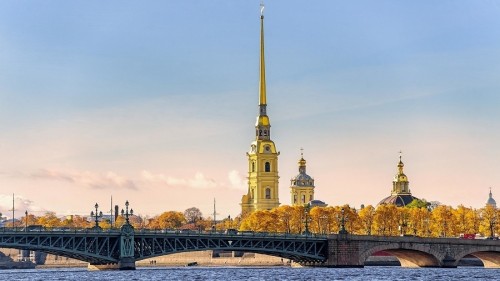The Peter and Paul Fortress is a simbol of St.Petersburg and one of the few remaining fortresses of the 18th century, the burial place of Russian emperors, as well as a former political prison of Russia. It was the one the history of St. Petersburg began with. On the teretorry of Zayachy Island, where the fortress stand on, just behind its wall, recided the main beach of the city. You can enjoy the marvellous view on Neva River and Hertitage from there, but swimming is forbidden at the moment.
As a result of the Russian Army victory, Russia got access to the Baltic Sea located strategically for the state security and economic development. To protect his territories, the emperor Peter I built a fortress on the island at the mouth of the Neva River, where it splits into sleeves, and called it St. Petersburg.
It was designed by the great monarch together with Lambert de Guerin (fortification architect) and Wilhelm Kirshtenshteynom, a Saxon engineer. Further fortress redevelopment was supervised by the famous Domenico Trezzini. The fortress is hexagon shaped with 6 bastions connected by the walls called curtains. The bastions were after Peter I and his closest.
The bastion walls are about 20 meters thick and 12 meters high – they were used as a basement for canon rampart and accommodation for the garrison. After Peter I death, during the reign of Empress Anna Ivanovna in 1733 – 1734, Alexei’s and Ioann’s Ravelins were built to protect the curtain gates from artillery fire, separated from the fortress with ditches and buried later in 19th century.
Although the Peter and Paul Fortress was intended to protect, it is renown as a political prison. Its first prisoner was Tsarevich Alexei, the son of Peter I, accused of conspiracy. In 18th century the fortress hosted Alexander Radishchev, Count Ostermann (an associate of Peter I), Regent Ernest Biron, Princess Tarakanova (false daughter of Empress Elizabeth).
Initially, prisoners were kept in the dungeons of the fortress, then a prison in the Alexis was built and called the Secret House. However, those arrested were kept in other dungeons of the fortress. In 1825 a fortress hosted the Semenov regiment soldiers, in 1825 – the Decembrists, in 1849 – Fyodor Dostoevsky.
After the Alexis Ravelin was destroyed, a new jail consisting of 69 single cells was built in the Trubetskoy Bastion – solely for political prisoners confinement and conditions being extremely harsh. About 1500 prisoners as total were kept in the fortress.
The February Revolution of 1917 brought royal ministers imprisoned in the Trubetskoy Bastion, the October Revolution – the Temporary Government members.
The Peter and Paul Cathedral is famous for being a burial place of the Russian emperors. It was built under the supervision of Trezzini to replace the wooden Peter and Paul Apostles’ Church and was consecrated in 1733. The Bell Tower enjoys a gilded spire with an angel high atop used as a weathercock. Early in 20th century St. Alexander Nevsky Church was built next to the cathedral to become a new imperial sanctuary and give rest to 13 members of the royal family.



